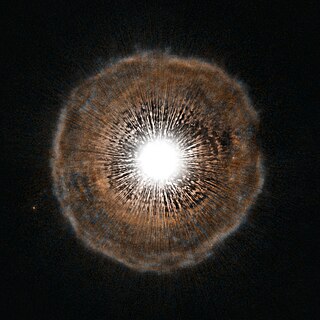Top Qs
Timeline
Chat
Perspective
U Camelopardalis
Star in the constellation Camelopardalis From Wikipedia, the free encyclopedia
Remove ads
U Camelopardalis is a semiregular variable star in the constellation Camelopardalis. Based on parallax measurements made by the Hipparcos spacecraft, it is located about 3,000 light-years (1,000 parsecs) away from the Earth.[1] Its apparent visual magnitude is about 8, which is dim enough that it cannot be seen with the unaided eye.
The spectral type of U Camelopardalis in the revised MK system is C-N5, which indicates a classical carbon star spectrum approximately corresponding to late K or early M.[10] The C2 index is 5.5 which is typical of a C-N star.[11] It is also given an alternative spectral type of MS4, indicating a star similar to an M4 class but with somewhat enhanced ZrO bands.[3] The spectral type may vary between C3,9 and C6,4e.[4]

In 1891, Williamina Fleming announced that the star (then known as DM +62°.596) is a variable star, based on 13 photographs taken in 1890 and 1891.[13] It was listed with its variable star designation, U Camelopardalis, in Annie Jump Cannon's 1907 work Second Catalog of Variable Stars.[14] U Camelopardalis is a carbon star. These types of stars have greater levels of carbon in their atmospheres than oxygen, which means they form carbon compounds that make the star appear strikingly red. U Camelopardalis is nearly 4 magnitudes fainter at blue wavelengths than in the centre of the visual range. In the infrared K band it has an apparent magnitude of 0.37.[15] Its brightness varies without a dominant period and it is classified as semi-regular, although a period of 400 days has been published.[15] In the V photometric band the brightness varies by around half a magnitude,[16] but the amplitude is nearly two magnitudes at blue wavelengths.[4] The maximum visual magnitude has been given as 7.2.[7]
The shell of gas surrounding U Camelopardalis was imaged by the Hubble Space Telescope in 2012, showing a nearly perfect sphere of gas surrounding the star.[17]
U Camelopardalis has a 10th magnitude companion 308" away. It is a B8 main sequence star, hotter but less luminous than U Cam itself. They are not thought to be physically associated.[7]
Remove ads
References
Wikiwand - on
Seamless Wikipedia browsing. On steroids.
Remove ads

